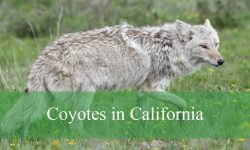Arizona’s diverse landscapes, from sunbaked deserts to lush grasslands, provide a home for a wide variety of grasshopper species. These insects are not only fascinating to observe but also play an important role in local ecosystems.
With their unique colors, patterns, and behaviors, grasshoppers in Arizona range from crop-feeding agricultural pests to desert specialists perfectly adapted to harsh, dry conditions. Each species can be identified by distinct markings, size, and habitat preferences.
In this guide, you’ll discover 15 types of grasshoppers found across Arizona, complete with pictures and identification details to help you recognize them in the wild.
Different Types of Grasshoppers Found in Arizona
Differential Grasshopper (Melanoplus differentialis)
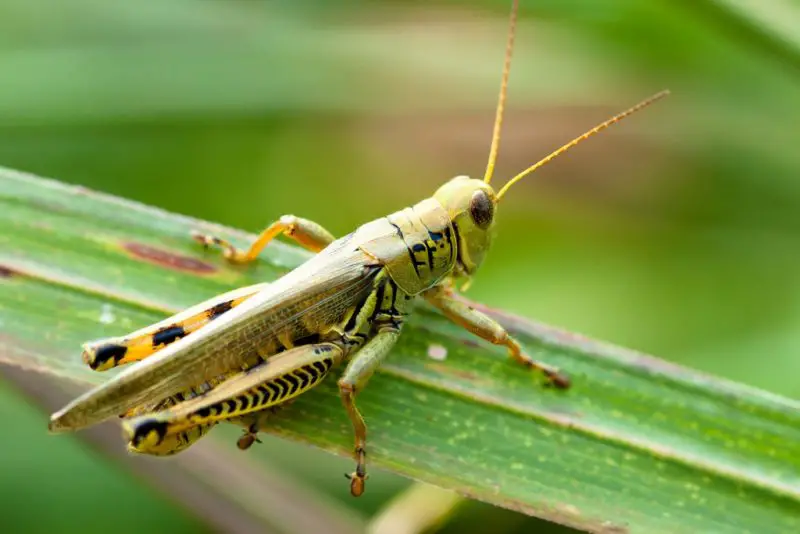
The Differential Grasshopper is one of the most recognizable species in Arizona due to its large size and distinctive yellow body marked with black chevrons on the hind legs. Adults typically measure about 1.5 to 2 inches in length, making them one of the larger grasshoppers in the region. Their coloration allows them to stand out against green crops and fields, making identification relatively easy.
This species thrives in open habitats such as agricultural fields, grasslands, and roadsides. It is especially abundant in areas where crops are irrigated, as the abundance of vegetation provides an excellent food source. Because of its adaptability, it is found in both rural and suburban areas, feeding on ornamental plants and lawns when crops are not available.
Behaviorally, the Differential Grasshopper is an active and strong jumper. It also flies readily when disturbed, making it difficult to catch. Adults are most common during late summer and fall, though nymphs emerge in the spring and develop throughout the warmer months. They are often seen basking in sunny areas during the day.
This species is considered one of the most damaging agricultural pests in the southwestern United States. It feeds on a wide variety of crops, including corn, alfalfa, wheat, and garden vegetables. In outbreak years, its populations can reach extremely high numbers, leading to severe economic losses for farmers.
Two-Striped Grasshopper (Melanoplus bivittatus)
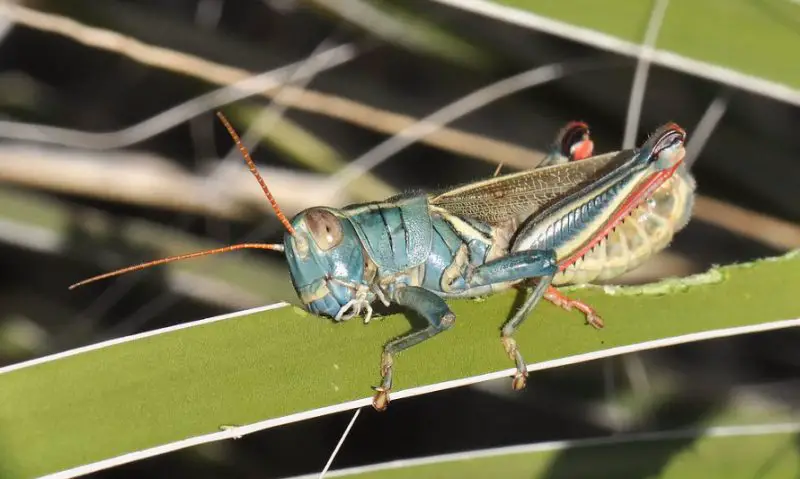
The Two-Striped Grasshopper is another common species in Arizona, named for the two light-yellow stripes running from the head down the wings. It is a medium to large grasshopper, usually around 1.5 inches long, and its body coloration ranges from green to brown, depending on habitat and surroundings. The stripes are the most reliable feature for identification.
This species prefers moist environments such as irrigated fields, meadows, and grassy valleys. It is particularly abundant in farming areas where alfalfa, corn, and other crops are grown. Because of its preference for lush vegetation, it is less common in arid desert regions but thrives in valleys and riparian zones where water is more available.
Two-Striped Grasshoppers are strong fliers and frequently move between patches of vegetation. They are diurnal, most active in the early morning and late afternoon, when temperatures are moderate. Their populations often peak in late summer, and they can sometimes appear in very large numbers that cause noticeable crop damage.
Like the Differential Grasshopper, this species has a broad diet and can feed on nearly every type of crop plant. Farmers often monitor its presence closely because it has the potential to cause serious agricultural losses when populations grow unchecked.
Pallid-Winged Grasshopper (Trimerotropis pallidipennis)
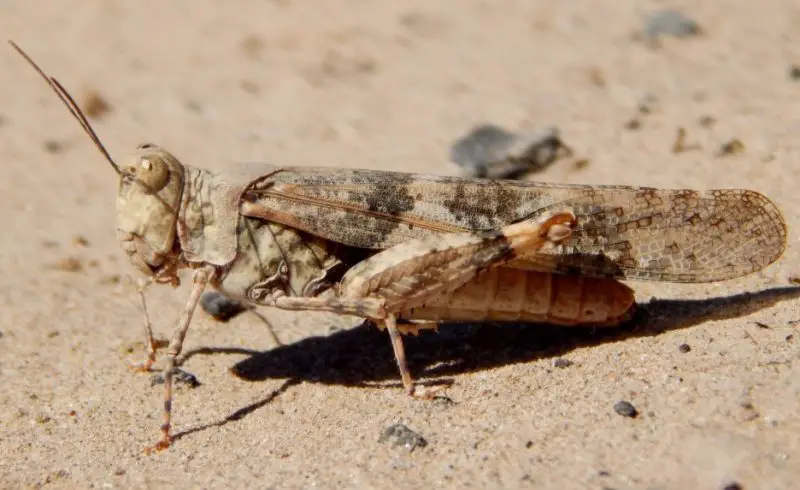
The Pallid-Winged Grasshopper is well adapted to Arizona’s desert landscapes. Its mottled gray and brown body allows it to blend seamlessly into sandy and rocky ground, making it difficult to spot until it takes flight. Adults usually reach about 1.25 to 1.5 inches in length, with pale-colored hind wings that are visible only during flight.
This grasshopper thrives in hot, dry habitats such as deserts, washes, and arid grasslands. It feeds mainly on grasses and desert plants, showing remarkable resilience in areas with sparse vegetation. It is especially common in the Sonoran Desert, where it remains active throughout the hottest parts of the summer.
Its flight behavior is one of its most distinctive features. When disturbed, the Pallid-Winged Grasshopper makes a loud rattling sound with its wings and takes off in strong, erratic flight. This sudden movement often startles hikers and other people walking through desert terrain.
Although not as notorious a pest as the Differential or Two-Striped Grasshopper, the Pallid-Winged Grasshopper can still cause damage to desert vegetation, particularly when populations increase during favorable conditions. However, its primary ecological role is to serve as a food source for desert birds, reptiles, and small mammals.
Red-Legged Grasshopper (Melanoplus femurrubrum)
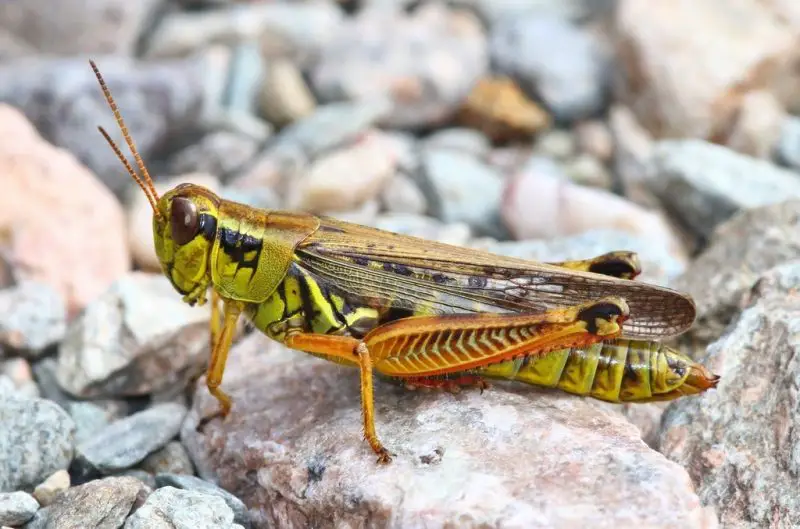
The Red-Legged Grasshopper is a smaller but very widespread species across Arizona. Adults typically measure about 0.75 to 1.25 inches in length and are identified by their reddish hind legs, which contrast with their brown, green, or sometimes yellowish body. This striking feature makes them relatively easy to distinguish from other common grasshoppers.
This species is highly adaptable and occurs in a wide range of habitats, including grasslands, lawns, agricultural fields, and riverbanks. Unlike some other species that are restricted to certain elevations or moisture levels, the Red-Legged Grasshopper can thrive in both natural and human-modified environments.
In terms of behavior, they are highly active during the day and often gather in large numbers in grassy fields. They prefer to feed on grasses and forbs but can also consume cultivated crops, particularly when natural vegetation is scarce. Their populations tend to increase rapidly during warm summers.
Because they are so widespread, Red-Legged Grasshoppers play an important role in the ecosystem as a food source for birds, amphibians, and reptiles. While they can be agricultural pests during outbreak years, their smaller size means they are generally less destructive than some of the larger grasshopper species in Arizona.
Spotted Bird Grasshopper (Schistocerca lineata)

The Spotted Bird Grasshopper is one of the larger species in Arizona, with adults measuring up to 2 inches long. Its body is typically light brown or green with darker spots along the thorax and abdomen, giving it a speckled appearance. The combination of large size and spotted markings makes it relatively easy to identify in the field.
This grasshopper is most common in semi-arid environments such as shrublands, dry grasslands, and desert margins. It can tolerate drier habitats compared to some other species but is also found in areas with more vegetation. Its strong flying ability allows it to move quickly between habitats in search of food.
When disturbed, the Spotted Bird Grasshopper takes off in long, powerful flights, often covering significant distances. This makes it an elusive species for collectors and observers. Its flight is quieter than the Pallid-Winged Grasshopper but still very noticeable due to the insect’s size.
The diet of this species includes a wide variety of grasses and broadleaf plants. Although it can feed on crops when near agricultural areas, it is not considered as serious a pest as some other Arizona grasshoppers. Instead, it plays an important ecological role in maintaining balance between desert plants and herbivores.
American Bird Grasshopper (Schistocerca americana)
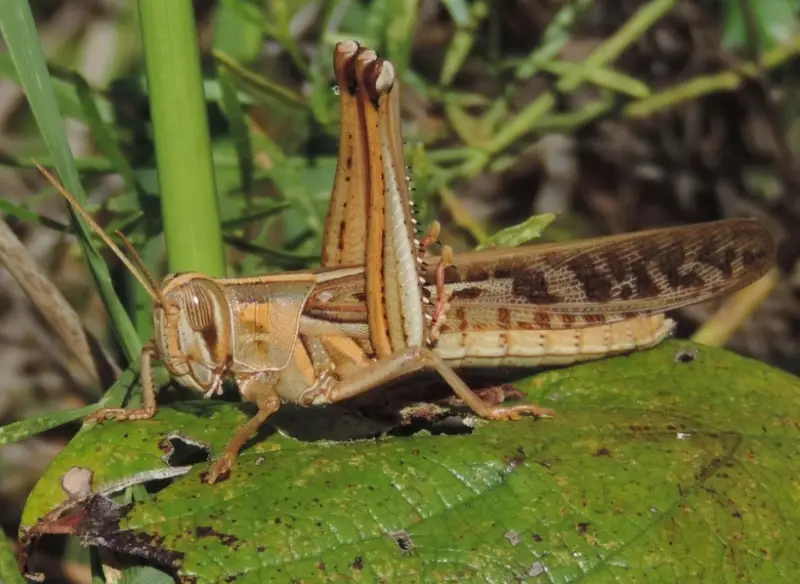
The American Bird Grasshopper is one of the largest species in Arizona, with adults reaching up to 2.5 inches in length. Their coloration varies from green to brown, sometimes with darker markings along the body. The large size and robust build make them easy to distinguish from smaller grasshoppers in the state.
This species inhabits open areas such as fields, rangelands, and agricultural zones. It is also found along forest edges and in semi-arid scrublands, showing its adaptability to diverse environments. Unlike some desert-specialized species, the American Bird Grasshopper prefers areas with moderate vegetation density.
Behaviorally, it is a strong and agile flier. When disturbed, it takes long flights across open areas, sometimes covering several hundred feet at a time. This mobility allows it to disperse widely, which can make it a challenge to control in agricultural settings.
As a feeder, the American Bird Grasshopper consumes a wide variety of plants, including both wild grasses and cultivated crops. During high population years, it can cause serious damage to corn, cotton, and other important crops, making it an agricultural concern in Arizona and across the southern United States.
Carolina Grasshopper (Dissosteira carolina)
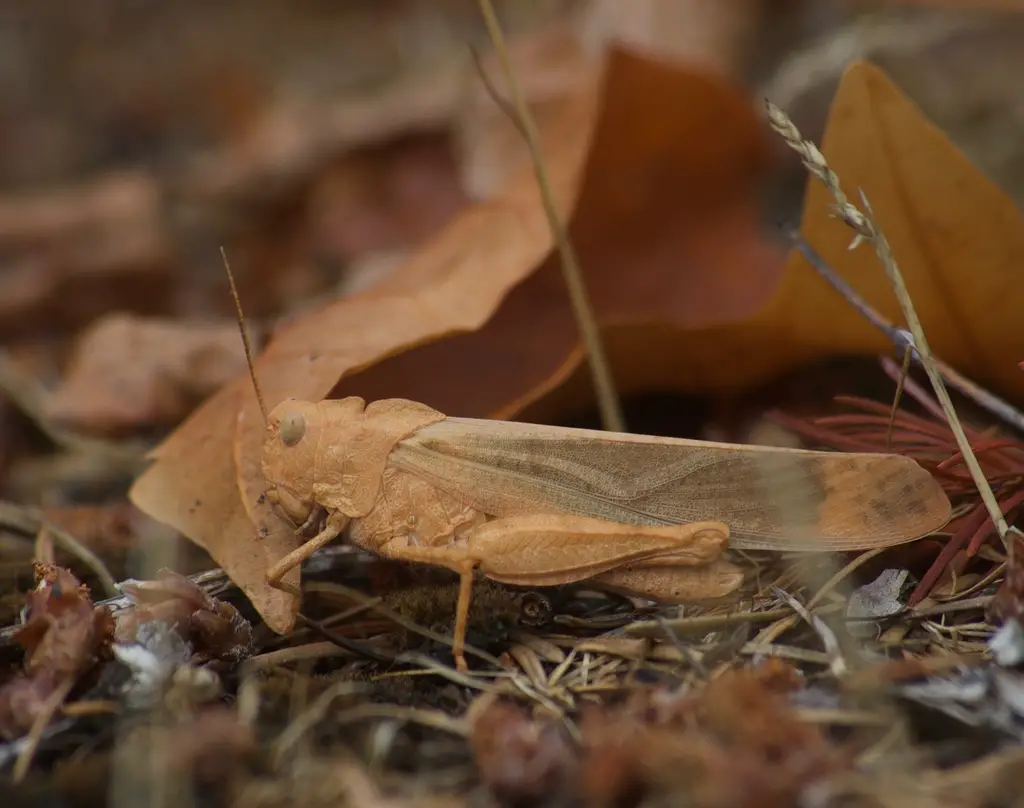
The Carolina Grasshopper, also known as the Black-Winged Grasshopper, is a medium to large species reaching about 1.5 to 2 inches long. It is usually gray or brown, which provides camouflage against gravel, soil, and bare ground. Its most distinctive feature is the black hind wings edged with a pale border, which are visible during flight.
This species thrives in dry, open habitats such as dirt roads, gravel lots, and sandy fields. It prefers sparsely vegetated areas where its coloration helps it blend in with the ground. In Arizona, it is commonly seen in disturbed habitats where vegetation is patchy.
When flushed, the Carolina Grasshopper takes flight with a strong flutter, flashing its dark hind wings before quickly settling back to the ground. This sudden contrast in wing coloration can startle predators and also helps observers identify it in the field.
The Carolina Grasshopper feeds on a variety of grasses and weeds but is not generally considered a major agricultural pest. Instead, it plays a more balanced role in the ecosystem, acting as a food source for birds, reptiles, and small mammals while grazing on common vegetation.
Migratory Grasshopper (Melanoplus sanguinipes)
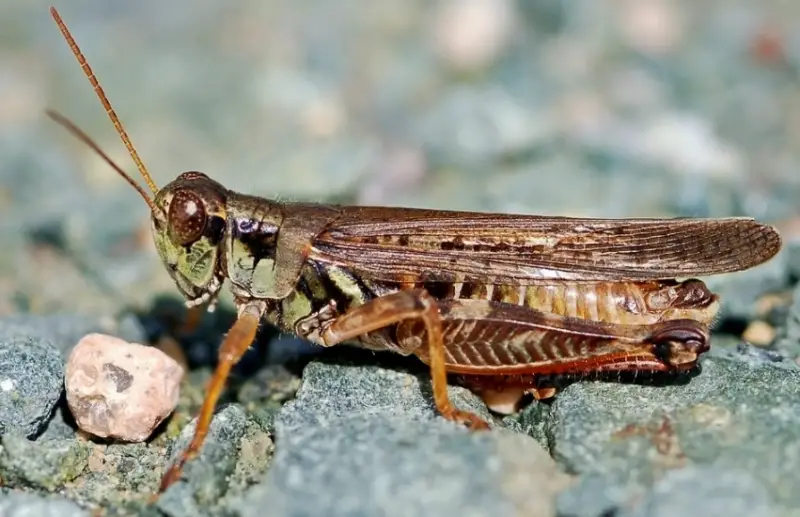
The Migratory Grasshopper is one of the most widespread and economically important grasshoppers in North America, including Arizona. Adults measure between 1 and 1.5 inches in length and are typically brown or gray, often with fine markings on the body and wings. Their relatively plain appearance can make them harder to identify compared to other species.
This grasshopper inhabits grasslands, prairies, and agricultural areas across the state. It thrives in environments with abundant grasses and crops, and its ability to survive in both natural and cultivated landscapes makes it highly adaptable. It is often most abundant in valleys and open plains.
One of its key traits is its potential for massive population growth under favorable conditions. During outbreak years, Migratory Grasshoppers can form large swarms that devastate crops and rangeland vegetation. This tendency makes them one of the most economically destructive grasshoppers in North America.
Their diet is broad, including both native grasses and cultivated crops such as wheat, barley, alfalfa, and corn. Farmers and ranchers in Arizona keep a close watch for this species, as it can inflict heavy losses on both crops and forage when populations rise sharply.
Striped Bird Grasshopper (Schistocerca alutacea)
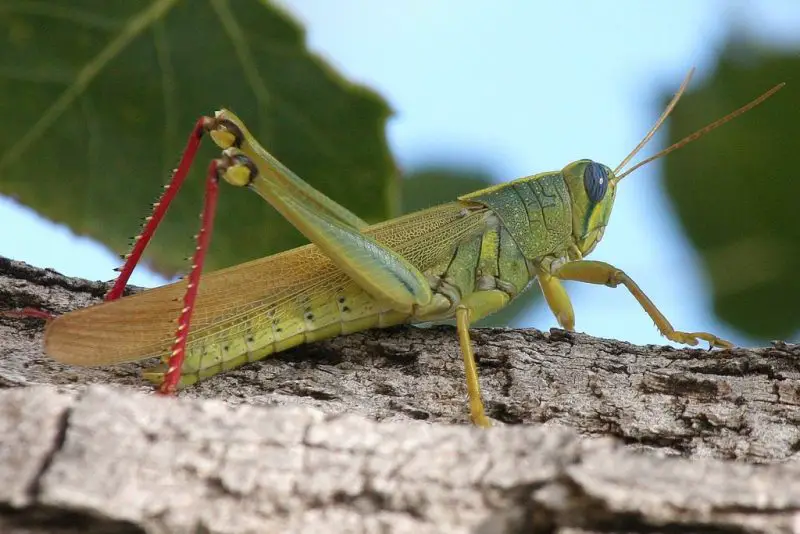
The Striped Bird Grasshopper is a large and striking species found in Arizona, with adults often measuring 2 inches in length. Its body coloration ranges from green to brown, but the most distinctive feature is the pale stripe running down each side of the body, which inspired its name.
This species is most often found in grassy fields, rangelands, and the edges of woodlands. Unlike some desert-adapted species, it prefers areas with more consistent vegetation. In Arizona, it is frequently encountered in grassier valleys and lowland habitats.
When disturbed, the Striped Bird Grasshopper launches into strong, sustained flights, often traveling considerable distances before landing. Its large size and visible stripes make it easier to identify in mid-flight compared to some of the smaller, plainer species.
As a feeder, it consumes a mix of wild grasses and broadleaf plants. It occasionally feeds on crops when present in farming areas, but it is not considered as destructive as species like the Differential or Migratory Grasshopper. Its ecological role is more balanced, providing food for birds and reptiles while grazing moderately on vegetation.
Lesser Migratory Grasshopper (Melanoplus packardii)
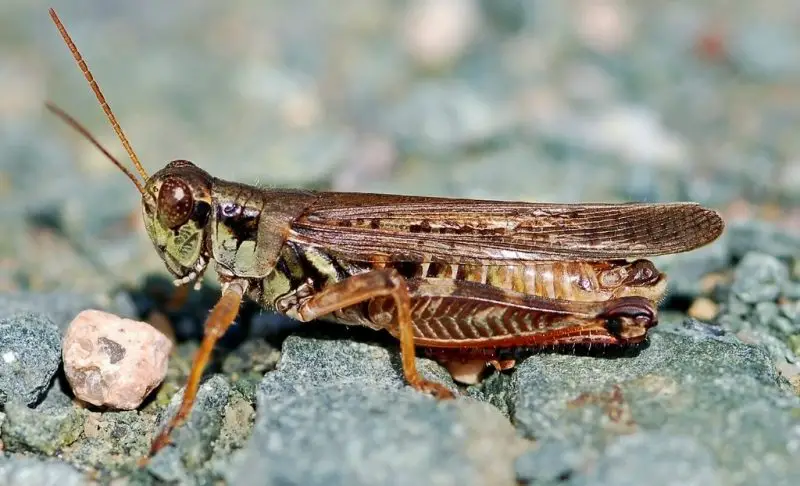
The Lesser Migratory Grasshopper is closely related to the more notorious Migratory Grasshopper but is generally smaller, with adults ranging from 0.75 to 1.25 inches in length. Its coloration is typically brown or gray, often blending well into dry grasslands and cultivated fields. Subtle markings help distinguish it from other Melanoplus species.
This species occurs in grasslands, agricultural fields, and prairies across Arizona. It is particularly common in open rangelands where grasses dominate. Its preference for grassy habitats makes it well adapted to both natural and human-modified landscapes.
Behaviorally, the Lesser Migratory Grasshopper is active during the day and readily takes short, quick flights when disturbed. Unlike some of the larger grasshoppers, it does not travel great distances, which makes it less prone to forming large migratory swarms.
While it can feed on a range of grasses and crops, it is generally less damaging to agriculture than the larger Migratory Grasshopper. However, in high numbers, it can still contribute to localized crop losses, especially in fields with alfalfa and cereal grains.
Green-Striped Grasshopper (Chortophaga viridifasciata)
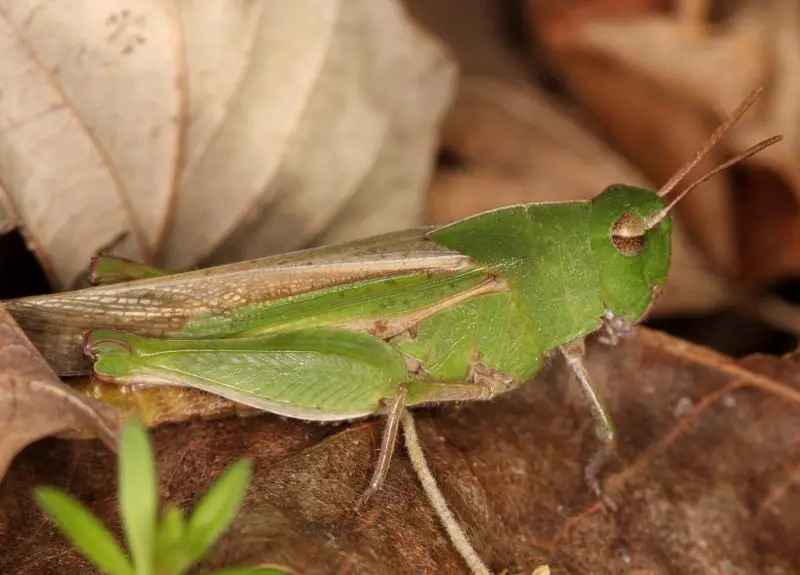
The Green-Striped Grasshopper is a medium-sized species, usually about 1 to 1.25 inches long. It is named for the green stripe that often runs down its back, though coloration can vary from green to brown depending on the season and habitat. Females are usually larger than males, and some individuals show more distinct striping than others.
This species thrives in moist, grassy habitats, making it more common in meadows, lawns, and agricultural fields than in the dry desert zones of Arizona. It can often be found in low vegetation near rivers or irrigation ditches where grasses are abundant. Its ability to thrive in disturbed habitats also makes it a frequent visitor to suburban areas.
Behaviorally, the Green-Striped Grasshopper is diurnal and most active during the day. It prefers to perch low on grass stems and leaps away quickly when disturbed. While it can fly, it usually takes only short, quick flights compared to some of the larger species in the state.
As a feeder, it primarily consumes grasses and small herbaceous plants. Although it occasionally nibbles on crops, it is not considered a major pest in Arizona. Instead, it serves as a steady food source for birds and small predators in grassy ecosystems.
Slant-Faced Grasshopper (Acridinae species)
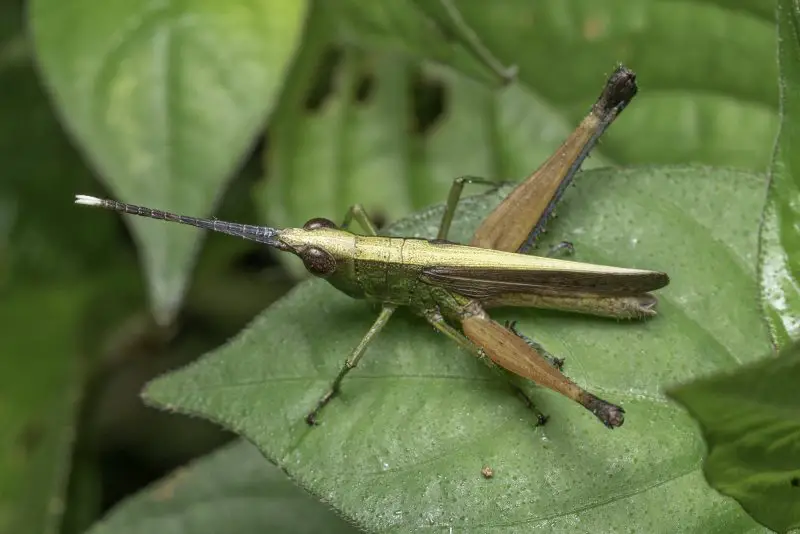
Slant-Faced Grasshoppers are a group of species within the Acridinae subfamily, known for their distinctive head shape that slopes forward, giving the appearance of a slanted face. These grasshoppers are generally slender and smaller than many other Arizona species, ranging from 0.75 to 1.25 inches in length.
They are most often found in natural grasslands and meadows, where their body shape and coloration provide camouflage among tall grasses. Unlike some of the larger, more conspicuous grasshoppers, slant-faced species tend to remain hidden and are less frequently noticed by casual observers.
In terms of behavior, these grasshoppers are quiet and secretive. They rely heavily on camouflage for protection and will usually hop only short distances when disturbed. Their flight is weak compared to the powerful bursts of species like the Carolina or Pallid-Winged Grasshopper.
Their diet consists mainly of grasses and sedges, and they play an important role in regulating plant growth in natural ecosystems. While not harmful to agriculture, they contribute to the balance of grassland environments by feeding selectively on certain plants.
Rusty Grasshopper (Syrbula admirabilis)

The Rusty Grasshopper is named for its reddish or rusty-brown coloration, though individuals may also appear yellowish or tan. Adults range from 1 to 1.5 inches long and are slender in build compared to heavier species like the American Bird Grasshopper. Its earthy tones allow it to blend into dry soils and desert vegetation.
This species prefers dry, open habitats such as deserts, scrublands, and sandy fields. In Arizona, it is particularly common in semi-arid regions where vegetation is sparse. It is well adapted to withstand hot, dry conditions and remains active during the peak of summer heat.
When disturbed, the Rusty Grasshopper makes quick, low flights before settling back on bare soil or among dry grasses. Its movements are not as dramatic as some of the larger grasshoppers, but its reddish coloration often becomes more visible in flight.
The Rusty Grasshopper primarily feeds on grasses and occasionally on low-growing desert plants. It is not a significant agricultural pest but plays a role in desert ecosystems by recycling plant material and serving as prey for reptiles, birds, and small mammals.
Blue-Legged Grasshopper (Oedipoda caerulescens, southwestern populations)
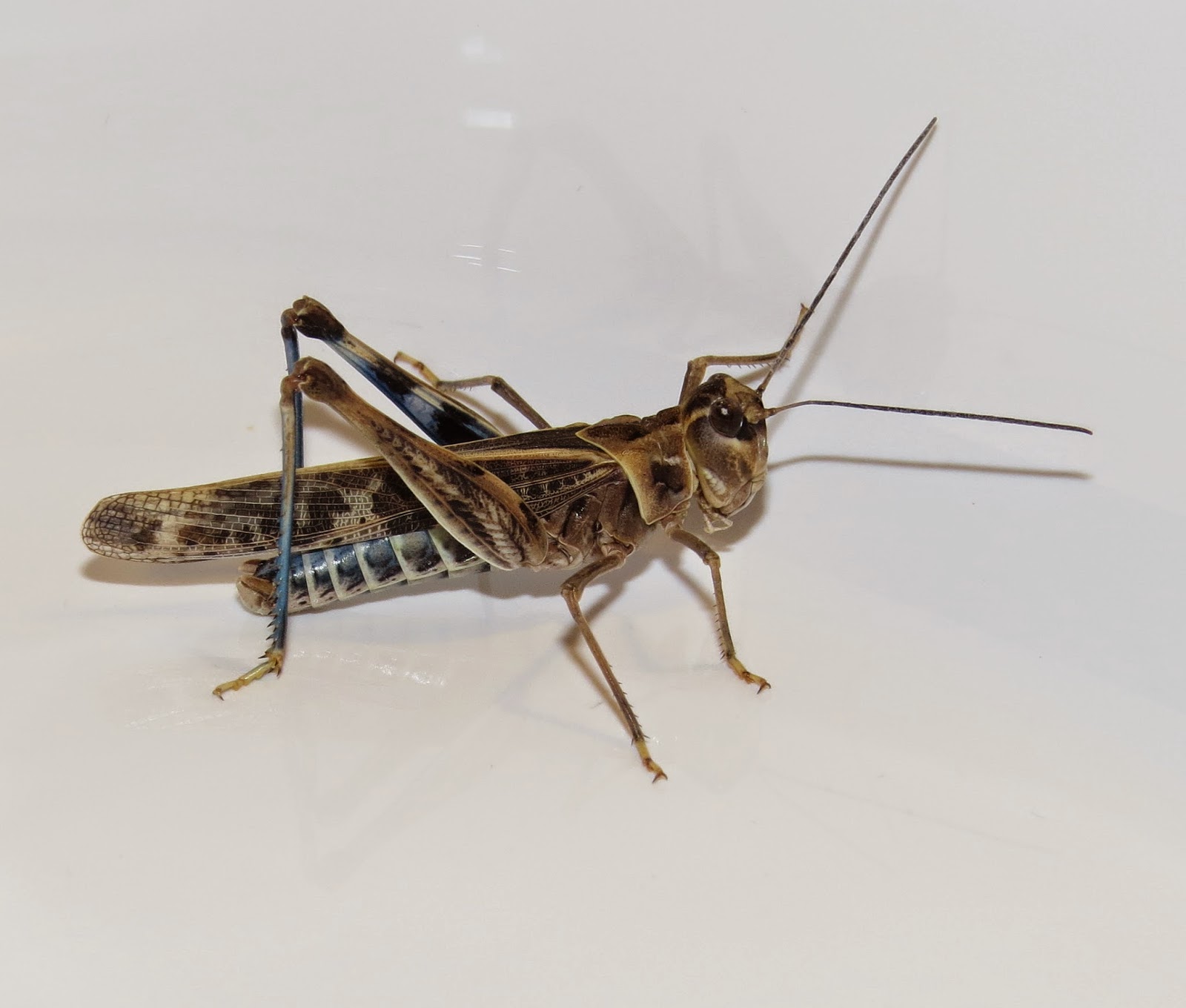
The Blue-Legged Grasshopper is notable for its striking hind legs, which often show bluish coloration, and its pale blue wings revealed during flight. Adults typically measure about 1.25 inches long and are otherwise cryptically colored in shades of gray and brown to match sandy soils.
This species favors dry, open habitats such as gravel plains, sandy washes, and rocky outcrops. Its camouflage makes it nearly invisible when resting on bare ground, but when startled, it flies up to reveal its bright blue hind wings, a defense mechanism that can confuse predators.
Behaviorally, the Blue-Legged Grasshopper is an excellent flier. Its flight is strong and often covers longer distances than many other similarly sized species. This makes it an effective disperser across desert landscapes, where food sources may be patchy.
Its diet consists mainly of grasses and other small plants growing in sandy soils. While it occasionally feeds on crops near desert farmland, it is not considered a major pest. Instead, it plays an important ecological role as prey for lizards and birds in arid regions.
Devastating Grasshopper (Melanoplus devastator)

The Devastating Grasshopper is named for its potential to cause severe damage to crops and rangelands. Adults range from 1 to 1.5 inches in length and are typically brown or gray with markings that provide camouflage against soil and vegetation. Its strong legs and robust body make it an efficient feeder.
This species occurs widely across Arizona, particularly in grasslands, rangelands, and agricultural zones. It is especially problematic in areas where forage crops like alfalfa are grown, as it can quickly reduce available vegetation for livestock.
In terms of behavior, the Devastating Grasshopper is highly active during the day and takes strong, rapid flights when disturbed. It is capable of moving in large groups, which increases its potential for agricultural damage. In outbreak years, populations can reach levels that strip fields of vegetation.
The diet of this species includes a wide variety of grasses and crops, with a particular preference for cereal grains and alfalfa. Because of its destructive potential, it is closely monitored by agricultural agencies in Arizona, making it one of the most economically important pest grasshoppers in the region.
Best Time and Places to Observe Grasshoppers in Arizona
Seasonal Activity
Grasshoppers in Arizona are most active from late spring through early fall, when warm temperatures encourage breeding, feeding, and growth. Nymphs typically emerge in April and May, depending on rainfall and temperatures, and they develop into adults by July and August. The peak of grasshopper activity generally occurs in the summer months, when populations are highest and adults are most visible. By late fall, numbers decline as cooler weather sets in, though some species can remain active into October and early November in warmer southern regions.
Urban vs. Rural Settings
In urban areas, grasshoppers can often be found in lawns, vacant lots, and along roadsides where weeds and grasses grow. They may also be spotted in gardens and landscaped areas, especially during outbreak years when populations move from surrounding fields. However, the most abundant and diverse populations occur in rural and natural areas, particularly in grasslands, rangelands, and desert margins. Agricultural fields, especially those with alfalfa or corn, attract high numbers of grasshoppers, including several pest species.
Best Locations in Arizona
The Sonoran Desert is an excellent place to observe desert-adapted species such as the Pallid-Winged Grasshopper and Rusty Grasshopper, which thrive in sandy washes and rocky outcrops. Grasslands of southeastern Arizona support species like the Red-Legged and Striped Bird Grasshoppers, while irrigated valleys and farmlands near Phoenix and Tucson are ideal for spotting the Differential and Two-Striped Grasshoppers. For those interested in observing grasshoppers in natural habitats, riparian zones, meadows near mountain foothills, and desert plains are among the most rewarding areas.
FAQs About Grasshoppers in Arizona
What time of day are grasshoppers most active?
Grasshoppers are diurnal, meaning they are most active during daylight hours. They often bask in the morning sun to warm up, feed heavily in the late morning and afternoon, and remain active until sunset.
Do grasshoppers in Arizona cause agricultural damage?
Yes. Several species, such as the Differential Grasshopper, Migratory Grasshopper, and Devastating Grasshopper, are considered serious agricultural pests. During outbreak years, they can inflict significant damage on crops like corn, alfalfa, and wheat.
Are grasshoppers dangerous to humans?
Grasshoppers are not harmful to humans. They do not bite or sting, and they do not carry diseases that affect people. Their primary impact is ecological and agricultural, where they serve as both herbivores and prey animals.
Where can I see the largest grasshoppers in Arizona?
The American Bird Grasshopper and the Spotted Bird Grasshopper are among the largest species in the state. They are most often seen in semi-arid grasslands, agricultural fields, and desert edges, where they can grow up to 2–2.5 inches long.
How do grasshoppers survive Arizona’s hot desert climate?
Many desert species, such as the Pallid-Winged Grasshopper, are adapted with cryptic coloration for camouflage and behavioral strategies like basking in the early morning and seeking shade during the hottest parts of the day. Their ability to feed on drought-tolerant plants also helps them thrive in arid environments.


